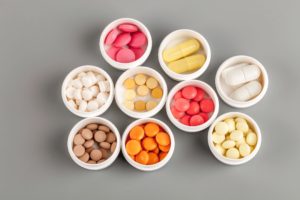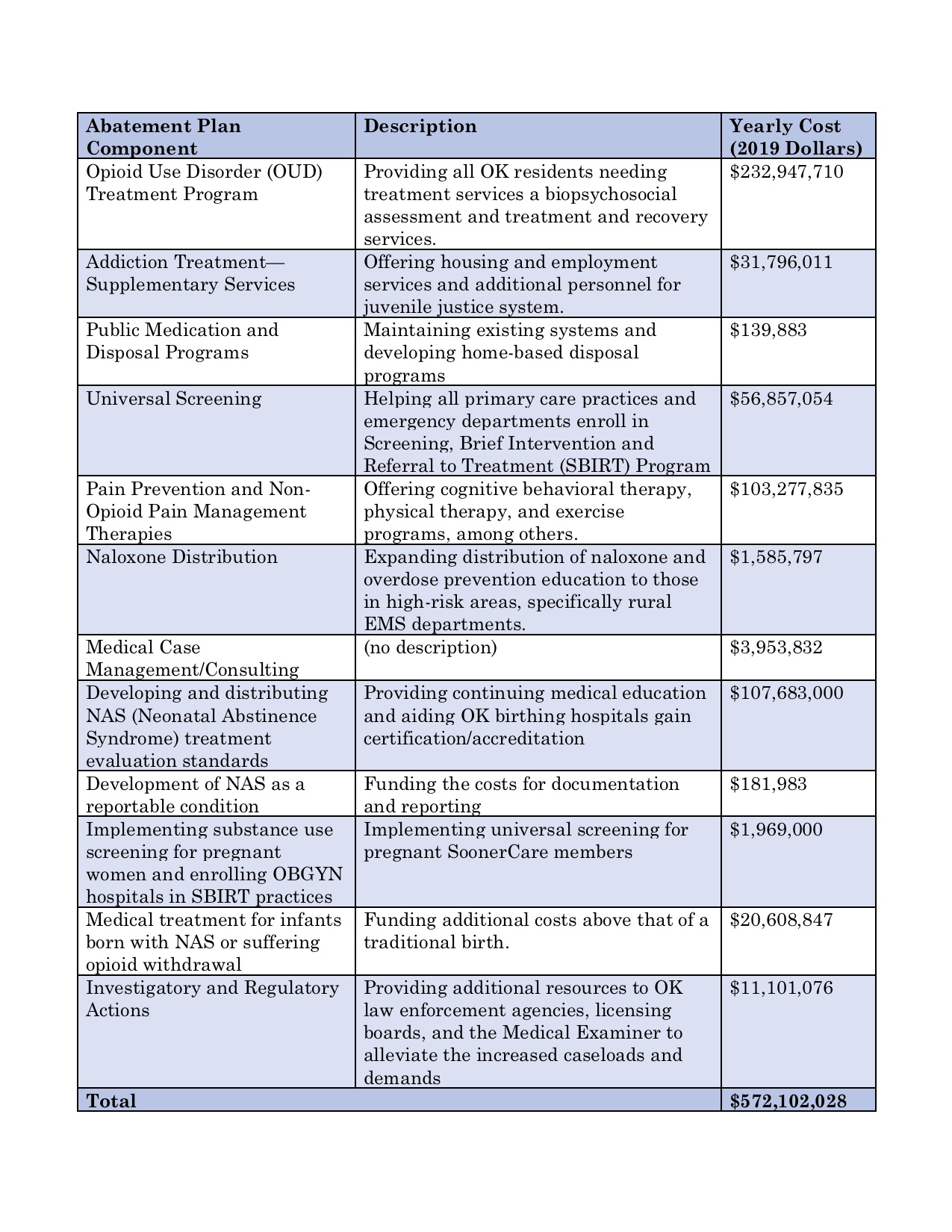
By Mary-Kathryn Hawes
As Walter Bender, Deputy Sheriff in Montgomery County, Ohio stated: “[O]pioids reach every part of society: blue collar, white collar, everybody. It’s nonstop. It’s every day. And it doesn’t seem like it’s getting any better.”[1] It is estimated that forty-six people die from opioid overdoses involving prescription opioids every day, with methadone, oxycodone, and hydrocodone being the most common drugs involved in these deaths.[2] It is further estimated that 4-6% of people who misuse prescription opioids switch to using heroin.[3] These few statistics[4] paint a dire picture: there is an opioid epidemic and we need help.
To that end, states, counties, and towns have filed lawsuits against big pharmaceutical companies, seeking to hold them responsible for the opioid epidemic and receive financial assistance to help pay for some of the astronomical costs inflicted by the scale of the opioid crisis.[5] One such case involved the State of Oklahoma suing major pharmaceutical companies (including Purdue, Teva, and Johnson & Johnson) under a public nuisance theory.[6] Purdue and Teva both settled prior to trial for $270 and $85 million, respectively.[7] However, Johnson & Johnson proceeded to trial, where they were handed a $572 million verdict on 26 August 2019 for deceptively marketing opioids and contributing to the opioid crisis.[8]
This verdict was splashed across television screens and newspapers when it was first rendered, with the underlying facts and findings of the case interestingly providing a bird’s eye view of how involved the pharmaceutical companies were in manufacturing this crisis. In seeking relief in state court, Oklahoma’s sole claim was that the pharmaceutical companies caused a public nuisance and the State sought abatement of that nuisance.[9] It was undisputed that in 2015, there were enough opioids prescribed in Oklahoma for each adult to have 110 pills.[10] Further, “[i]n 2017, 4.2% of babies born covered by SoonerCare [Oklahoma’s state Medicaid] were born with Neonatal Abstinence Syndrome . . . a group of conditions caused when a baby withdraws from certain drugs [that] it’s exposed to in the womb before birth.”[11] Oklahoma is a microcosm of the epidemic ravaging the United States.
In finding Johnson & Johnson caused a public nuisance, Judge Thad Balkman ruled that Johnson & Johnson “marketed, promoted and sold opioid drugs in Oklahoma” since the mid-1990s.[12] The judgment devotes a few pages to discussing Johnson & Johnson’s subsidiary companies. As part of a “pain management franchise,” Johnson & Johnson was owned two subsidiary companies, Tasmanian Alkaloids Limited and Noramco, Inc., from the 1990s through at least 2016.[13] Tasmanian Alkaloids, based in Tasmania (a province of Australia), “cultivated and processed opium poppy plants to manufacture narcotic raw materials” that were imported into the United States and processed by Noramco.[14] Anticipating demand for opioids, in 1994, Tasmanian Alkaloids developed a “high thebaine” opium poppy plant to “enable[] the growth of oxycodone.”[15] Noramco subsequently processed these raw materials into the active pharmaceutical ingredients used in opioids and supplied both Johnson & Johnson and other pharmaceutical companies with these active ingredients.[16] Johnson & Johnson maintained these subsidiaries to “ensure a reliable source of [narcotic] raw materials” and “security of supply.”[17]
Shrouded behind a positive public image as the maker of familiar products like Band-Aids and baby powder, Johnson & Johnson was, and still is, a major player in the opioid supply business. Judge Balkman found that Noramco was used by Johnson & Johnson to supply the top seven generic drug companies with active pharmaceutical ingredients used in opioid manufacturing.[18] Specifically, Noramco provided other manufacturers with “oxycodone, hydrocodone, morphine, codeine, buprenorphine, hydromorphone, and naloxone.”[19] Eventually, Noramco “grew to become the No. 1 narcotic [active pharmaceutical ingredient] supplier of oxycodone, hydrocodone, codeine, and morphine in the United States.”[20]
The judgment then spends several pages detailing exactly how Johnson & Johnson “embarked on a major campaign in which they used branded and unbranded marketing to disseminate the messages that pain was being undertreated and there was a low risk of abuse and a low danger of prescribing opioids to treat chronic, non-malignant pain and overstating the efficacy of opioids.”[21] Specifically, Johnson & Johnson promoted that pain was undertreated in an effort to encourage providers to prescribe opioids as the solution.[22] The Court found that Johnson & Johnson utilized the term “pseudoaddiction” to “convince doctors that patients who exhibited signs of addiction . . . were not actually suffering from addiction, but from the undertreatment of pain; and the solution, according to Defendants’ marketing, was to prescribe the patient more opioids.”[23]
Further, in 2004, the FDA sent Johnson & Johnson a letter noting that a file card used to promote their product Duragesic (a skin patch containing fentanyl, a highly addictive opioid) was false or misleading because the card suggested that “Duragesic has a lower potential for abuse compared to other opioid products” and could “encourage the unsafe use of the drug.”[24] In conjunction with these instances, Johnson & Johnson used “education from Defendants’ sales representatives, literature funded by Defendants in medical journals and publications, materials from professional societies/patient advocacy groups, continuing medical education funded by Defendants, unbranded marketing materials, and Defendants’ paid speakers” to influence doctors’ prescribing habits and encourage them to utilize opioids to treat pain.[25]
In finding that Johnson & Johnson committed a public nuisance, the Court relied on the statutory definition of a nuisance as “unlawfully doing an act, or omitting to perform a duty, which act or omission either: [f]irst, [a]nnoys, injures, or endangers the comfort, repose, health, or safety of others . . . .”[26] While some states require the use of property to commit a nuisance, Oklahoma has interpreted their public nuisance statute to exclude the use of property, and instead, only requires “unlawfully doing an act, or omitting to perform a duty.”[27] Alternatively, the Court found that if Oklahoma law does require the use of property in committing a nuisance, the State still satisfied its burden by demonstrating that “Defendants pervasively, systematically and substantially used real and personal property, private and public, as well as the public roads, buildings and land of the State of Oklahoma, to create this nuisance.”[28] Ultimately, the Court concluded that “Defendants’ false, misleading, and dangerous marketing campaigns have caused exponentially increasing rates of addiction, overdose deaths, and Neonatal Abstinence Syndrome,” which are “unlawful acts which annoys, injures, or endangers [sic] the comfort, repose, health or safety of others.”[29]
The Court also found that there were no supervening or intervening causes that “supervened or superseded Defendants’ acts and omissions as a direct cause of the State’s injuries.”[30] Thus, the Court found that Johnson & Johnson created a public nuisance that should be remedied by equitable abatement.[31] After detailing Oklahoma’s Abatement plan (described in the table below), the Court found that Oklahoma needed $572,102,028 to carry out the plan in its first year.[32] Even though several of Oklahoma’s witnesses testified that the abatement plan required at least 20 years to be effective, the Court found that the State did not provide sufficient evidence to establish the costs necessary for that timeframe, and thus, were not awarded damages past the first year.[33]
Table 1: Overview of Oklahoma’s Abatement Plan[34]

So, why
does all of this matter? Not only is the Oklahoma case the first national civil
litigation suit for the opioid epidemic that went to trial,[35] it
seriously holds a major pharmaceutical company accountable for catalyzing the
opioid epidemic. Johnson & Johnson, along with the other major
pharmaceutical companies, aggressively marketed opioids as a low-risk solution
to pain, when they were anything but. As Gary Mendell, founder and CEO of the
advocacy group Shatterproof, stated: “Today’s monumental decision in Oklahoma
is a critical step in setting a precedent for the largest public health crisis
facing our country, bringing justice to the lives lost, and reversing the
course of addiction crisis for future generations.”[36]
[1] James Nachtwey, The Opioid Diaries, Time, Mar. 5, 2018, at 1.
[2] Overdose Death Maps, Ctr. for Disease Control & Prevention (Aug. 13, 2019), https://www.cdc.gov/drugoverdose/data/prescribing/overdose-death-maps.html.
[3] Opioid Overdose Crisis, Nat’l Inst. on Drug Abuse (Jan. 2019), https://www.drugabuse.gov/drugs-abuse/opioids/opioid-overdose-crisis#seven.
[4] As with many subjects, statistics don’t tell the whole story. No one wants to be an addict and I would be remiss if I did not point readers to an article sharing individual quotes and perspectives on this crisis. See Nachtwey, supra note 1; see also Families Impacted By The Opioid Crisis Testified at Johnson & Johnson Trial, NPR (Aug. 28, 2019), https://www.npr.org/2019/08/28/754962728/families-impacted-by-the-opioid-crisis-testified-at-johnson-johnson-trial (“I wish that someday people would realize I’m not a bad person. I’m a good person with a bad disease.”).
[5] See, e.g., German Lopez, The Thousands of Lawsuits Against Opioid Companies, Explained, Vox (Sep. 11, 2019, 4:30 PM), https://www.vox.com/policy-and-politics/2017/6/7/15724054/opioid-epidemic-lawsuits-purdue-oxycontin.
[6] See generally Oklahoma ex rel. Hunter v. Purdue Pharma L.P., No. CJ-2017-816 (Okla. Dist. Ct. [Cleveland Cty.], Aug. 26, 2019), https://archive.org/download/balkmanopioidjudgment/Balkman-Opioid-Judgment.pdf.
[7] Jackie Fortier & Brian Mann, Johnson & Johnson Ordered to Pay Oklahoma $572 Million in Opioid Trial, NPR (Aug. 26, 2019, 4:19 PM), https://www.npr.org/sections/health-shots/2019/08/26/754481268/judge-in-opioid-trial-rules-johnson-johnson-must-pay-oklahoma-572-million.
[8] Hunter, at *41–42.
[9] Id. at *2 (citing Okla. Stat. Ann. tit. 50, § 1-44 (West 2017)).
[10] Id.
[11] Id.
[12] Id. at *4.
[13] Id. at *5.
[14] Id.
[15] Id. at *7–8.
[16] Id. at *5–6.
[17] Id. at *7 (alteration in original) (quotations omitted).
[18] Id. at *8.
[19] Id.
[20] Id. at *9.
[21] Id. at *9.
[22] Id. at *10. At the time, pain was sometimes referred to as the “fifth vital sign” in a push to have providers respond to patient complaints of pain. See Natalia E. Morone & Debra K. Weiner, Pain As the Fifth Vital Sign: Exposing the Vital Need for Pain Education, 35 Clinical Therapeutics 1728 (2013).
[23] Hunter, at *11.
[24] Id. at *4–5, 18.
[25] Id. at *9–10.
[26] Id. at *22. (citing Okla. Stat. Ann. tit. 50, § 1 (West 2017))
[27] Id.; see also Paul L. Keenan, Note, Death by 1000 Lawsuits: The Public Litigation in Response to the Opioid Crisis Will Mirror the Global Tobacco Settlement of the 1990s, 52 New Eng. L. Rev. 69, 75-77 (2017) (detailing the various theories of liability that communities are using in their lawsuits against pharmaceutical companies).
[28] Hunter, at *24.
[29] Id. at *25–26 (quotations omitted).
[30] Id. at *29.
[31] Id. at *30.
[32] Id. at *41.
[33] Id. (emphasis added).
[34] Id. at *30–41.
[35] Jackie Fortier, Pain Meds As Public Nuisance? Oklahoma Tests a Legal Strategy For Opioid Addiction, NPR (July 16, 2019, 4:49 PM), https://www.npr.org/sections/health-shots/2019/07/16/741960008/pain-meds-as-public-nuisance-oklahoma-tests-a-legal-strategy-for-opioid-addictio.
[36] Statement on Johnson & Johnson Oklahoma Trial Verdict, Shatterproof (Aug. 26, 2019), https://www.shatterproof.org/press/statement-johnson-johnson-oklahoma-trial-verdict.





